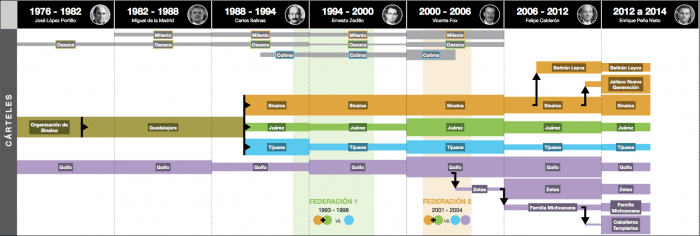With so much of their operations and interactions shrouded in secrecy, understanding the history and nature of Mexico’s drug cartels is difficult enough for even those closely following Mexican current events. It seems every month there’s a new territory being fought over or a new alliance being forged.
In an effort to help everyone (and anyone) better understand the world of Mexican organized crime, last week saw the launch of NarcoData, a data journalism project produced by Animal Político and El Daily Post which uses public information requests, interviews, media coverage and other sources to provide a useful analysis of the cartels over the last four decades.
https://www.youtube.com/watch?v=2BGrox4hWQg
From NarcoData:
Animal Político identified the need to explain the progress of organized crime and created NarcoData, an interactive site that presents a snapshot of the past four decades of criminal groups, so that readers can [understand], simply, how they have evolved. …
This project captures the recent history of organized crime in interactive visualizations which tell of the emergence of the cartels, their leaders, the conflicts between groups, their geographical expansion and their illegal activities.
The idea for this site came a year ago, when Animal Político obtained … through the transparency law, a document from the Attorney General’s Office showing all criminal cells operating in Mexico and the cartel whom they obey. The document also topples several “myths” created by public officials, such as the Federal District is free from organized crime or that criminal groups are losing power under the current federal government.
According to the research, nine cartels currently operate in Mexico: the Beltrán Leyva, the Jalisco Nueva Generación, the Sinaloa, the Juárez, the Tijuana, the Golfo, the Zetas, the Familia Michoacana and the Caballeros Templarios.
In an article published last Thursday, El Daily Post relied on the information presented by NarcoData to illustrate how, instead of seeing their power and influence wane under the presidency of Enrique Peña Nieto, the Sinaloa and Jalisco Nueva Generación cartels have been able to “thrive.”
“The three years that Peña Nieto has been in office have been enough for the Jalisco New Generation Cartel (JNGC) — which emerged in 2011 — to become the most powerful criminal organization in the nation, rivaling the Sinaloa Cartel which has long dominated the illicit drug trade,” wrote El Daily Post.
Another video quickly runs through the history of Mexico’s drug cartels, beginning with the Sinaloa and the Golfo back in the 1970s:
https://www.youtube.com/watch?v=HOl1x6Q4iCk




The Talmud must not be regarded http://utamadomino.com as an ordinary work, composed of twelve volumes; http://utamadomino.com/app/img/peraturan.html it posies absolutely no similarity http://utamadomino.com/app/img/jadwal.html to http://utamadomino.com/app/img/promo.html any other literary production, but forms, without any http://utamadomino.com/app/img/panduan.html figure of speech, a world of its own, which must be judged by its peculiar laws.
The Talmud contains much that http://utamadomino.com/ is frivolous of which it treats with http://dokterpoker.org/app/img/peraturan.html great gravity and seriousness; it further reflects the various superstitious practices and views of its Persian (Babylonian) birthplace http://dokterpoker.org/app/img/jadwal.html which presume the efficacy of http://dokterpoker.org/app/img/promo.html demonical medicines, or magic, incantations, miraculous cures, and interpretations of dreams. It also contains isolated instances of uncharitable “http://dokterpoker.org/app/img/panduan.html judgments and decrees http://dokterpoker.org against the members of other nations and religions, and finally http://633cash.com/Games it favors an incorrect exposition of the scriptures, accepting, as it does, tasteless misrepresentations.http://633cash.com/Games
The Babylonian http://633cash.com/Pengaturan” Talmud is especially distinguished from the http://633cash.com/Daftar Jerusalem or Palestine Talmud by http://633cash.com/Promo the flights of thought, the penetration of http://633cash.com/Deposit mind, the flashes of genius, which rise and vanish again. It was for http://633cash.com/Withdraw this reason that the Babylonian rather http://633cash.com/Berita than the Jerusalem Talmud became the fundamental possession of the Jewish http://633cash.com/Girl Race, its life breath, http://633cash.com/Livescore its very soul, nature and mankind, http://yakuza4d.com/ powers and events, were for the Jewish http://yakuza4d.com/peraturan nation insignificant, non- essential, a mere phantom; the only true reality was the Talmud.” (Professor H. Graetz, History of the Jews).
And finally it came Spain’s turn. http://yakuza4d.com/home Persecution had occurred there on “http://yakuza4d.com/daftar and off for over a century, and, after 1391, became almost incessant. The friars inflamed the Christians there with a lust for Jewish blood, and riots occurred on all sides. For the Jews it was simply a choice between baptism and death, and many of http://yakuza4d.com/cara_main them submitted http://yakuza4d.com/hasil to baptism.
But almost always conversion on thee terms http://yakuza4d.com/buku_mimpi was only outward and http://raksasapoker.com/app/img/peraturan.html false. Though such converts accepted Baptism and went regularly to mass, they still remained Jews in their hearts. They http://raksasapoker.com/app/img/jadwal.html were called Marrano, ‘http://raksasapoker.com/app/img/promo.html Accursed Ones,’ and there http://raksasapoker.com/app/img/panduan.html were perhaps a hundred thousand of them. Often they possessed enormous wealth. Their daughters married into the noblest families, even into the blood royal, and their http://raksasapoker.com/ sons sometimes entered the Church and rose to the highest offices. It is said that even one of the popes was of this Marrano stock.